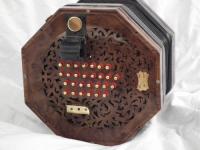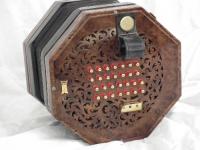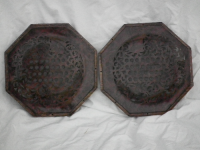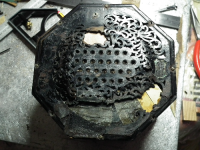-
Posts
1,670 -
Joined
-
Last visited
Everything posted by SteveS
-
I see that this is now up at £4675 with 14 hours to go. Edit: I see that a change in the exchange rate has revised the current price down to £4560. Sold for $7,279.99
-
.thumb.jpg.e5ef9a111c1064c0bbea848f22aab7fe.jpg)
Anybody knows the player Len Henry Jones?
SteveS replied to conzertino's topic in General Concertina Discussion
Steve, Sorry, but large photos aren't really suitable for here. I'll see what I can do elsewhere, and let you know. OK thanks Wes. -
.thumb.jpg.e5ef9a111c1064c0bbea848f22aab7fe.jpg)
Anybody knows the player Len Henry Jones?
SteveS replied to conzertino's topic in General Concertina Discussion
Wes (or possibly Geoff Crabb) are you able to upload a version of the larger photo - would be nice to have a closer look at the other concertinas in that photo. -
I see that this is now up at £4675 with 14 hours to go. Edit: I see that a change in the exchange rate has revised the current price down to £4560.
-
Where the 3D printer is useful is in prototyping. Prototype ends could be designed on CAD packages, modelled in software and then printed out. After being furnished with fittings, they could be tested. Ends may accept a suitable finish (eg. ebonising) for production instruments. Reed pans of different formats/dimensions could also be prototyped. In fact the whole instrument could be prototyped - it doesnt need to function as a production instrument, but prototyping is an essential part of productizing a new design. The dimensions, look/feel can all be worked out prior to commiting time (loads of time required in making concertinas) to the creation of an instrument. The whole instrument design could be made on a CAD package, and I believe that a number of modern makers are already using CAD for component manufacture for production instruments. The ability to interface with CAD may greatly ease the production of some parts - like as I mentioned previously, lever arms, buttons, fretted ends, bellows frames, etc.
-
This is all getting a little serious. Can we pull the thread back to the original theme? I was anticipating some discourse with wild & whacky ideas on how 3D printing technology could be applied to the concertina. Thinking caps on then.....
-
Geoff & Chris Many thanks for your comments. With regards to making you some ends Chris, I think I'd like to recover from making these before considering making more It was a lot of hard work, but satisfying Steve
-
Thanks Ross, appreciate your comments. I've uploaded slightly larger pictures at your suggestion. Steve
-
I've now completed the ends. All that remains now: - adjust the action - retune the reeds - repairs to the bellows This will get the 'tina playing well. The initial indications are that this plays smooth and the reeds have great dynamics. I plan to improve the appearance of this instrument - new bellows & thumbstraps in suitably matching brown hide.
-
Just read an article on 3D printing. Now that prices of 3D printers are set to fall dramatically, they could become more readily available. How could this technology be applied to the concertina? Discuss. My immediate thought was printing of buttons, levers, ends. And the concertina could potentially become recycleable too. Fancy a Jeffries? - throw the old 'tina in the shredder and print yourself one. Steve
-
.thumb.jpg.e5ef9a111c1064c0bbea848f22aab7fe.jpg)
Played my Jeffries for BBC 2s Blas Ceoil,!
SteveS replied to Ptarmigan's topic in General Concertina Discussion
Thoroughly enjoyed that - well done all. -
Geoff - glad to see you back.
-
.thumb.jpg.e5ef9a111c1064c0bbea848f22aab7fe.jpg)
Highland Sessons 1/6 tonight Nov 19/2010 BBC 4 2030-2100
SteveS replied to Kautilya's topic in Concertina Videos & Music
Highland Sessions or this one Alternative -
.thumb.jpg.e5ef9a111c1064c0bbea848f22aab7fe.jpg)
Restoring an Instrument Procedure
SteveS replied to varney's topic in Instrument Construction & Repair
The order in which I'll do things are: - assess the 'tina for work to be undertaken - make list of parts to be acquired or made - good clean inside and out (working in 100+ years of filth can be unpleasant) - repair & polish ends/fretwork - action board repairs - clean & bush buttons, clean fittings - reassemble ends, bush button holes - pads & reset action - valves & chamois (if required) - bellows repairs - retune -
.thumb.jpg.e5ef9a111c1064c0bbea848f22aab7fe.jpg)
International Concertina Association 06-11-2-10
SteveS replied to Leo's topic in Concertina Videos & Music
Enjoyed those - thanks for posting. -
I see from the Wheatstone price lists that they refer to 'Special Composition Metal Reeds for damp and tropical climates' - were these reeds really brass or some other material(s)? Or is brass just an assumption?
-
Theo - this is not my filing but appears to be the original filing (I havent yet started the tuning) so I'd have expected a uniform tarnish across the whole surface of the reed.
-
As you may be aware from another thread I'm in the process of rebuilding a brass reeded Aeola TT (I'll update that thread with pics of the new ends shortly). Last night I was on with replacing the valves when I noticed something peculiar with the reeds. On some of the reeds there seems to be a shiney area that looks very much lighter than the yellow of the brass - almost white like steel, and where the tuning file (historical tuning) has taken metal away it appears to have penetrated to this lighter layer. It's almost as though the reeds are of a light-coloured metal (I hesitate to say steel since there's no sign of rust at all) - which has been plated with brass. Any ideas what this might be? Steve PS Also I've almost got the 'tina playing - the indications are that the reeds are very loud, warm and very responsive - more details later once I get it playing for real.
-
It's not always possible to bolt everything back up - I'm thinking of times when say during the stages of French polishing the ends when the ends must be off the instrument - bolting back up runs the risk of damaging the new shellac around the bolt holes - so the ends may need to be off the instrument for some time. What do folks do then?
-
Great - thanks all for helping to solve the mystery.
-
Spotted on Looks like an Anglo - thumbstraps like an EC but seems to have a much wider hand span of buttons than an Anglo, left hand appears to be low notes. Any ideas? Steve
-
These blades are wider than the blades I used - this means that many of the tight / narrow points and corners would not be quite as sharp - for an intricate design like with my application I felt a very thin blade was more appropriate. They may however be suitable for the more open type of fretwork seen on some concertinas. Whatever type of blade is used does not obviate the need to reset the blade in the machine blade clamps between each fret cut.
-
Thanks - I estimate at least 50 hours went into cutting the fretwork - using a scrollsaw. But I cut them over a 10 day period, so wasn't all in one sitting. I can really appreciate the work that went into cutting the fretwork by those who did it day-to-day.
-
The ends now completed and French polished. Waiting for the newly gold-plated labels to be added and the button holes to be bushed. All metalwork will be plated and new bellows and thumbstraps made. Also attached is another before picture - this time of the right hand end. The original ends were a mess. Steve
-
This instrument is no longer for sale.





